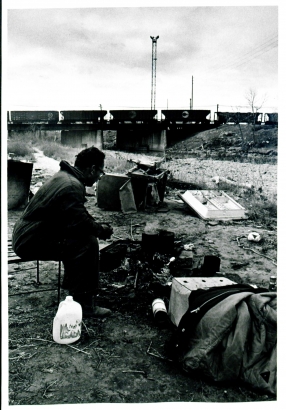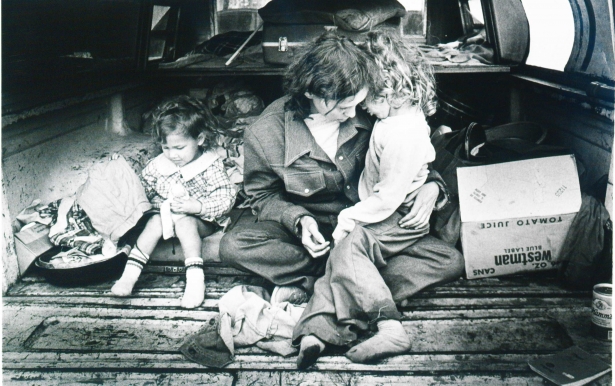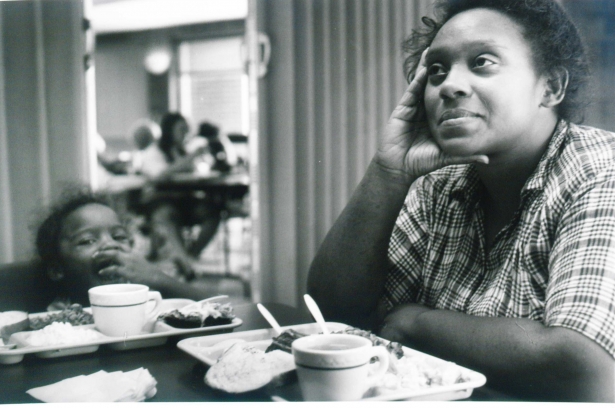While the 1960s were, in many ways, a period of social revolutions, little reprieve came to those in need of housing. It didn't help that the massive flood of 1965 destroyed both traditional housing stock as well as encampments along the Platte Bottoms. At the same time, Larimer Street had developed a reputation as Denver’s skid row. Much of this stretch of downtown was populated by unemployed, underemployed, and retirement-age men. Alcoholism was rampant, and according to the Denver Post, many individual years saw thousands of arrests for drunkenness. Larimer was full of cheap hotels and flophouses where beds could be had for under a dollar. Many missions were also set up to help with addiction treatment and to serve as social alternatives to taverns. It was a world of unrelenting struggle that could have been ripped from the pages of Bukowski, or Zola for that matter.
Enter the 1960s solution to urban blight: the Denver Urban Renewal Authority (DURA). Funded by Housing and Urban Development along with a local bond, DURA oversaw the removal of much of the low-income housing in central downtown, as well as the largely Hispanic community of Auraria. While many homeowners were granted stipends to move and purchase comparable homes, this did little to aid the chronically unhoused. By 1969, some small strides had been made, including the establishment of the Wazee Center, meant to serve people seeking recovery from alcoholism, although many people continued to live along the river and even in abandoned boxcars.
The Wazee Center conducted studies of the men who utilized their services. A sampling of over 400 men appeared in the Denver Post on May 14, 1970, with some interesting results. The vast majority were white. Over half were divorced or separated from their spouses. Over 44% were military veterans. Two-thirds were over the age of 40. While the Wazee Center was able to serve 300 men per day, other businesses in Lower Downtown objected to having them as neighbors. The Center shut down in 1974, and DURA’s redevelopment of Skyline and Larimer Square continued to push the unhoused population toward 17th and Market Streets and further north along Larimer Street.
A new alcohol detox program began in 1974, but funding was cut the next year, reducing the number of beds from 134 to 24. Organizations such as the Men’s Assistance Center, the Salvation Army, and the Denver Rescue Mission attempted to fill in the gaps and shift more resources towards treatment needs, but efforts were seldom commensurate with the need. On November 4, 1977, the Denver Post ran an article highlighting a new focus by downtown law enforcement to “clear out winos.” Besides the usual round-up of those visibly intoxicated, police began focusing on “bootleggers” who would buy liquor during the day and sell it at inflated prices when liquor stores and taverns were closed. As one might imagine, and as pointed out by one detective who was interviewed, this did nothing to get at the root of the problem. The culture of the area had become so notorious that Tom Waits even mentions the corner of 17th and Wazee Streets in his 1975 song, “Nighthawks Postcard.”
By 1977, more attention was being paid to the impact of redlining in promoting detritus and eroding housing stock in poor communities of color. While redlining was officially ended by the Fair Housing Act of 1968, it was not until 1977 that the Community Reinvestment Act was passed in an effort to roll back decades of negative impacts caused by redlining. In Denver, the Lenders Mortgage Corporation was formed as a nonprofit with cooperation from seven lending institutions. As is the case with so many examples of systemic discrimination, undoing the damage has been difficult.
The 1980s brought a boom and bust in the oil markets that caused a new construction boom to end with a glut of abandoned buildings in downtown Denver. This ensured that, throughout the decade, Lower Downtown would continue to be known as Denver’s skid row. At the same time, the drop in tax revenue meant more reliance on the already struggling charities designed to serve people who were unhoused. A Rocky Mountain News article from December 24, 1989, followed Roy Chappell, a representative of the Salvation Army who would drive around trying to bring people out of the sub-zero temperatures and back to the shelter. He said that during the course of his four years at the job, he had brought in over 70 people who had been living under a single bridge over 8th Avenue and Speer Boulevard. Some had erected primitive plywood structures while others had less protection. Several of these people had to be transported to the hospital for treatment of frostbite.
The 1990s brought no reprieve. A study released in 1991 showed the number of homeless families in the state had risen by 68% between 1988 and 1990. According to a Denver Post article from September 19,1991, the closure of Denver’s largest family shelter and major cuts to mental health programs both occurred within 1991. The same article quoted John Parvensky, director of the Colorado Coalition for the Homeless, who plainly stated,
“We're going in the wrong direction in dealing with this problem.”
This theme echoes decade after decade in Denver. As downtown gentrification kicked off, more stories appeared in the press covering the construction of shacks and other makeshift housing along the banks of the Platte River. On April 26, 1992, the Rocky Mountain News even reported on an unhoused couple growing vegetables next to their plywood home along the river. It was a story that could have been written in 1870.
One of the more interesting 1990s communities was established along the Platte Bottoms under Park Avenue. It was named “Clintonville'' and had its own mayor, named Knuckles. The rules included “no violence, no drugs, no lies, and no stealing,” although alcohol was welcome. Residents were forced out in 1997 to make way for a new city park.
History, in this case, does not simply rhyme but continues to sing the same song. We don't yet know yet what the 21st century will see in terms of ending homelessness. That said, the early 21st-century boom in Denver's housing market is not a positive indicator.
If you want to learn more about how these issues impact people today and/or want to get involved, see the following links:
Colorado Coalition for the Homeless has an educational series.
Interfaith Alliance offers the opportunity for people to sign up for information on legislative action.
Denver's Office of Housing Stability serves as advocates.
Metro Denver Homeless Initiative offers the opportunity to join councils and committees to work on the issue.






Comments
The last Republican mayor of
The last Republican mayor of Denver was in 1963. I’m sure if we keep voting the same way, things will get sorted out!
Thanks for reading about this
Thanks for reading about this bit of Denver history. You might take a look at part one of this series. This issue long predates the 1960s and spans numerous parties in leadership.
Hello everyone, I am Sam…
Hello everyone, I am Sam Harrison from LA, Connecticut. I want to recommend Mr Brian Stone and his team who has had to deal with these internet swindlers, I lost my entire savings after investing in a cryptocurrency platform, I was told I would gain huge profits from my investment not knowing they were setting me up for a huge scam. If you have had a similar experience, I strongly recommend you contact brienstone02@gmail.com or WhatsApp him +1 (336)257-8835. as they were able to recover all my money in 48 hours. They are the best when it comes to recovering stolen money from these online swindlers. Reach them direct: brienstone02@gmail.com or via their Telegram: t.me/brainStones
Add new comment